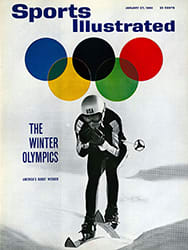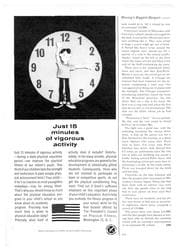
The fastest boy in the West challenges a champion
Three years ago in Boston a 17-year-old Canadian youngster named Bruce Kidd ran in a two-mile race against grown men and startled the stopwatches out of everyone by running it in 8 minutes 49.2 seconds—which is something like getting elected governor at the age of 23. No one had ever heard of a 17-year-old running two miles that fast before, and no one heard of it since, until last Saturday night in Los Angeles.
There, at the fifth annual Los Angeles Invitational Track Meet, a skinny little high school kid who will not be 18 until March 9 ran two miles in 8 minutes and 46 seconds flat, breaking Kidd's record and completely shattering, obliterating, squashing and otherwise doing away with any U.S. citizens' records for boys running in men's races.
The youngster, Gerry Lindgren of Spokane, had caught the attention of track followers three weeks earlier when he won a two-mile race at a San Francisco indoor meet in 9 minutes flat, which was more than 20 seconds better than the previous best two miles ever run by a high schooler. Times get tedious, but in Los Angeles last weekend young Lindgren broke his own previous best by 14 seconds—which meant that he had lowered the American high school record by more than half a minute in just two tries. He is the best distance-running prospect America has ever had. He is better than Bruce Kidd was at the same age. He is a senior in high school, and it is hard to think of a senior in college who is as good as Lindgren.
This does not mean, however, that he is the best distance runner in the world—not yet, anyway. Lindgren finished second in his 8:46 race in Los Angeles. Ahead of him by 35 yards at the finish was Gaston Roelants, a handsome Belgian with a mustache, the world record holder in the 3,000-meter steeplechase and the favorite to win the steeplechase at the Olympics in Tokyo next fall. Unlike most European runners who come over in the winter for a spot of racing on the boards, Roelants was in superb competitive condition. He said that just the week before he had won a five-mile cross-country run in Belgium over a course that was five inches deep in snow. Roelants is not only a fine runner and a true competitor; he has élan. He used to be a cop—one of his superiors was Roger Mo√´ns, one of the best half-milers ever to poke a spike into cinder—but a few months ago Gaston said farewell to the policeman's lot and became a liquor salesman. He has not disclosed whether he grew his mustache before or after he began selling apéritifs, but it certainly is a dashing bit of foliage.
Roelants was the man to watch in the race, but young Lindgren ripped away from the start with a veteran's poise and took the lead on the backstretch of the first lap. Roelants followed in second place, and Julio Marin, a Costa Rican who used to run for the University of Southern California, was third. The first American of college age was Danny Murphy of San Jose State, who ran fourth for half the race, and the first American old enough to have grown-up worries was George Young, running fifth in his first serious race since he came down with ulcers a year ago when he was an insurance salesman. Young gave up coffee and selling, became a schoolteacher, calmed his ulcers and resumed running. Watching Lindgren may bring back George Young's ulcers.
The pacesetter
Lindgren set a brisk, steady pace, and the field followed. Pale, with a boyish face, he is only 5 feet 5 inches tall and weighs but 118 pounds. One could not help but feel that he had taken the lead for a few laps just so the folks back home could see him on television. The crowd waited for Roelants to pass young Gerry, but Gaston the Belgian seemed content with the pace. When the time at the mile, the halfway point, was announced, the crowd understood why. Lindgren had passed it in 4:21.2, outstandingly fast time, a pace that would break Murray Halberg's arena record if repeated in the second half.
But that seemed Lindgren's high point, for Roelants moved up a lap later and took the lead away from the youngster. Marin moved past, too, and so did Young. Suddenly Lindgren found himself in fourth place. It seemed a shame but hardly surprising, and it appeared likely that he now would drift all the way back to last. But he held on to fourth place. With about four laps to go, Roelants picked up the pace and began to pull away. Young moved past Marin into second place. Then, electrically, Lindgren sprinted. He passed Marin. As Roelants opened his lead to 10 yards, Lindgren dueled Young. With a lap and a half to go and Roelants running away from the field, Lindgren slipped by Young and ran strongly the rest of the way home. The crowd roared its approval. Roelants, on his way to the arena record, a splendid 8:41.2 two-mile in his first U.S. indoor race, was almost unnoticed.
After the race a group of Los Angeles Belgians gathered around Roelants, kissed him on both cheeks and presented him with a huge bouquet of flowers. Gaston held the bouquet high with his right hand and jogged around the track as everyone applauded. That was nice. Young Gerry Lindgren, looking as fresh as a sprinter, wandered into the infield, grinning with pleasure. He waved at someone in the crowd and bent over to take off his track shoes. An older runner, wearing a U.S. Olympic sweat suit, walked past him and, shaking his head in wonder, patted him affectionately as he went by. That was nice, too.
Later, Lindgren said he had taken the lead from the beginning because "I like to run my own race. That 4:21 was a little fast. I was aiming at 4:22," he added, seriously. "But I didn't have any special time for the whole race. I just wanted to get below nine minutes."
Lindgren broke a bone in his foot as a sophomore, and it bothered him again last spring. It was what he calls a "march" fracture, and he got it from running too much. He was on crutches for three weeks and then took it easy. Now the foot is fine. He is a senior at John Rogers High in Spokane and has just succeeded Maury Wills as the most famous athlete in the Inland Empire.
He intends to run in only one more indoor meet this year, the Golden Gate Invitational in San Francisco on Feb. 15. He has his eye on the Olympics, and his youth and diminutive size argue against too much competition too soon. Along with being chronologically young, he is very young-looking: in a crowd of teen-age boys Lindgren could pass for 14. Asked if he thought he might yet grow bigger, Gerry smiled and said, "I don't know. I guess not. But I don't care if I don't grow anymore."
Aside from Lindgren, the performers who caught one's eye at the Los Angeles meet were four toothsome girls from Texas and Pole Vaulter John Pennel. Pennel had to stop off in the Midwest on his way from Louisiana to Los Angeles and, to avoid carrying his vaulting poles with him everywhere he went, he sent them on ahead in care of an airline. Bad weather forced the plane to set down at an alternate landing site, where the poles (they were tucked under a row of seats) were overlooked. When last heard from they were headed for Indianapolis or Denver or Alaska. Pennel picked up a new pole from a manufacturer in Costa Mesa, just outside Los Angeles. But vaulting on untried fiber glass is an extremely tricky proposition, since each of the hyper-springy poles has its individual characteristics insofar as spring and snapback are concerned. C. K. Yang said, "They throw you this way. They throw you that way. You have to know the pole."
Pennel, the only 17-foot vaulter in captivity, missed on his first try at 15 feet (the beginning height for this field was limited to 16-foot vaulters), but he made the second. At 15 feet 6 inches he went straight up, hit the bar and came straight back down, landing half in the foam rubber of the pit and half on the hard floor. He jammed his heel and scraped his left shin against the wooden corner of the runway, drawing blood. He limped up and down for a while, went into the trainers' room, came out, limped some more and finally tried 15 feet 6 again. At the end of the runway, going full speed, he abandoned the attempt, let go his pole and did a perfect forward somersault onto and over the five-foot-high pile of foam rubber in the pit. Several minutes later he tried again and made it, and the crowd yelled as though he had done 18 feet. Then he vaulted 16 feet and then 16 feet 4¼ inches to set a new American indoor record. All in all, it was a remarkable performance.
As for the girls, they run for the Texas Track Club. With their teased coiffures and lipstick and eye makeup, not to mention their trim figures and pretty legs, they look like a quartet of refugees from Disc Jockey Dick Clark's American Bands land, the teen-age TV show. But they can run. One of them, a very blonde blonde named Mary Rose, won the 'women's 500-yard run. As she crossed the finish line a gallant official leaped out to catch her and, exhausted, she sagged in his arms. It is a thankless job, being a track official, but some days it is sort of fun.
PHOTO
WELCOMING NEWCOMER to exclusive society of world-class runners, Roelants throws arm over Lindgren's shoulder after record two-mile.

